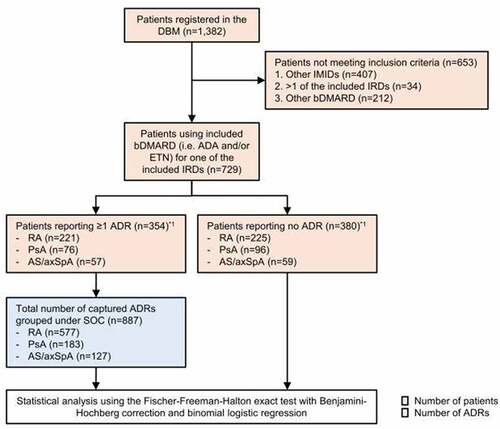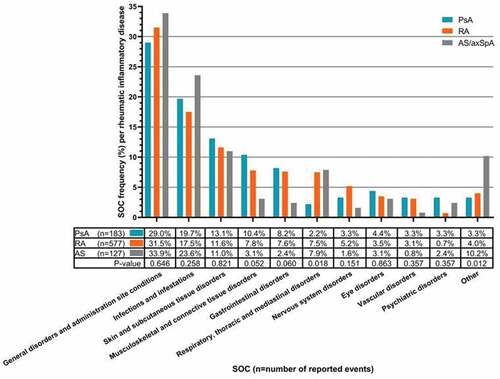Figures & data
Figure 1. Flowchart of the study design. Inclusion criteria were (1) one immune-mediated inflammatory disease (IMID), i.e. rheumatoid arthritis (RA), psoriatic arthritis (PsA) or ankylosing spondylitis/axial spondyloarthritis (AS/axSpA) and (2) the use of adalimumab (ADA) and/or etanercept (ETN) for their IMID. aThe combined number of patients from both groups (n = 734) exceeds the total number of included patients (n = 729) as 5 patients that had switched in bDMARD treatment reported an ADR with one, but not with the other bDMARD. Dutch Biologic Monitor (DBM); adverse drug reaction (ADR); System Organ Class (SOC); Inflammatory rheumatic diseases (IRDs).

Figure 2. The frequency (%) of patient-reported ADRs per IRD, attributed to the use of anti-TNF drugs. ADRs were grouped under MedDRA® system organ class (SOC). SOCs contributing for less than 1.5% to the total number of SOCs were grouped under ‘other.’ p-Values indicate the difference in frequencies of the ADRs between the different IRDs. Inflammatory rheumatic disease (IRD); rheumatoid arthritis (RA); psoriatic arthritis (PsA); ankylosing spondylitis (AS) including axial spondyloarthritis (axSpA).

Table 1. Characteristics of patients registered in the DBM that use anti-TNF drugs for their IRD.
Table 2. Logistic regression estimates of patient characteristics associated with the reporting of ADRs categorized by SOC.
Data availability statement
The data are not publicly available due to legal restrictions related to data privacy protection. However, the data are available from the corresponding author upon reasonable request after authorization from the DBM board.
